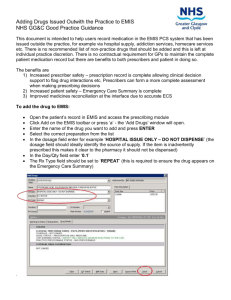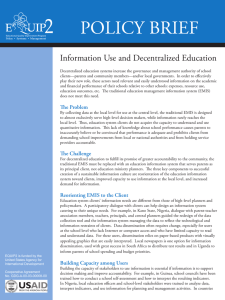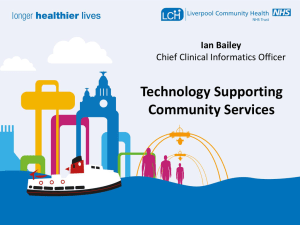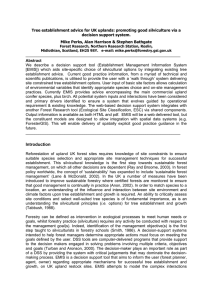EMIS - Community Data Program
advertisement
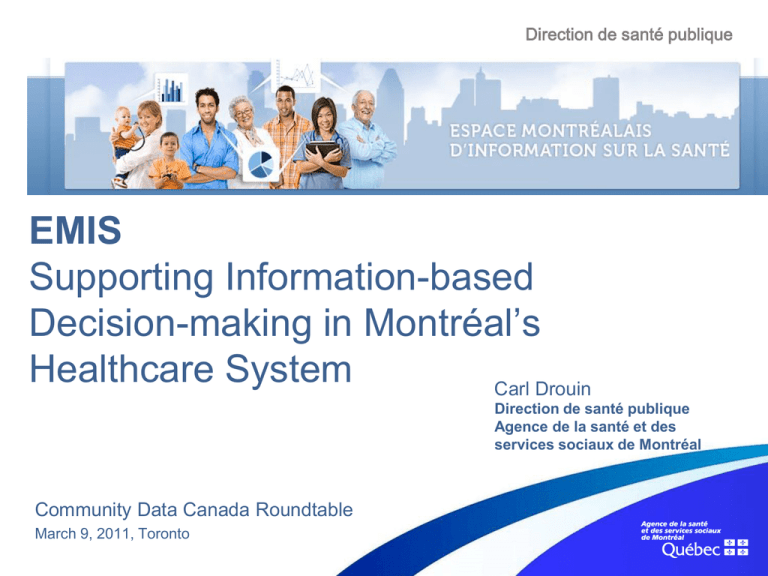
Direction de santé publique EMIS Supporting Information-based Decision-making in Montréal’s Healthcare System Carl Drouin Direction de santé publique Agence de la santé et des services sociaux de Montréal Community Data Canada Roundtable March 9, 2011, Toronto Presentation outline Context in which EMIS was created Key principles guiding our strategy in public health data dissemination Demo of EMIS Website Content and structure Tools Concluding remarks Organizational context of EMIS Data-related responsibilities Ministry of health and social services 18 regional ‘’agencies’’ Public health division Local networks 12 local Health and Social Services Centres (CSSS) in Montreal Medical service providers Municipalities and boroughs Community organizations Schools and school boards Etc. Manage and provide information on the health (services INFO ONcare THEsystem HEALTH SYSTEM delivered, resources, performance, etc.) + Track the health status of Montrealers INFO ON PEOPLE’S HEALTH (surveillance) Inform the population and decision = and its makers about health determinants SUPPORT PLANNING IN HEALTH Plan and provide services according to population health needs Advantages of EMIS Organizational perspective A single platform using same tools and technologies More integration in data collection Uniformity in data treatment Less duplication in production and dissemination processes Development and maintenance supported by a larger group with complementary skills (IT, GIS, analytical expertise related to Service programs and PH data) User’s perspective A single reference on health data in Montreal (with same structure, interactive Web-based tools and analytical publications) Same data can be used for different purposes Participate in Website development and validation of further improvements Provide settings to enhance data-driven decision-making Key principles Go local when possible Diversify products Standardize analytical products and tools Develop products and Website with partners and data users Integrate within a larger Web strategy (design, technology) Provide local data Census geography (CTs and DAs) Health administrative units CSSS, CLSS, voisinages By health institutions (e.g. hospitals) Sometimes adapted to other geographies (school boards) More and more of our PH publications are done in series of 12 (CSSS) Working on a local survey program 111 neighbourhoods Different products for diversified users Key health issues Health profiles (population / space-based) • Selection of key variables for major themes • Comparisons to others • Trends Microdata level More meaningful information •= more efforts •= more users? •= used for • decision- making? Interactive tools Standardized analytical products Chiffres-clés (Key numbers) Place-based (neighbourhoods) characteristics - Montreal Partnerships Partners Local health centres (through Data Users’ Committee and working groups) Information providers within the organization (mainly PH subdivisions) Roles Express needs, validate proposals; test applications; promote use of data Provide surveillance data within their field of expertise; use available technologies and products Communications department Web strategy; support information process; advise on best practices Computer department Advise on technological orientations; support development Agency’s Website redevelopment Agency’s corporate Website Regional portal Zone for physicians Other health data Websites EMIS Local Websites Zone for professionals Public health director’s Website DEMO Concluding remarks Challenges to be met Allow the time required to increase the value of the data Keep a large amount of data and information up-to-date Continuous feeding of those involved in surveillance Support data utilization among local and community partners Work on structural (e.g. menus) and technological (e.g. indicators module instead of Excel and PDF files) improvements Key message Such type of Website requires to be part of a larger information system (i.e. data – qualified HR – tools – standardized processes) Ideas for discussion How can data really provide bases for reduction in social health inequalities?


